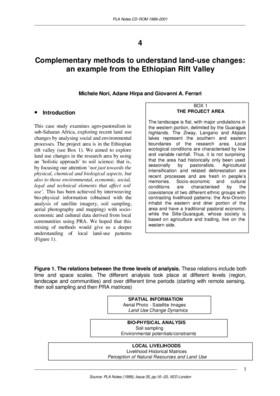PLA Notes CD-ROM 1988-2001 4 Complementary methods to understand land-use changes: an example from the Ethiopian Rift Valley

Document begins: PLA Notes CD-ROM 19882001 4 Complementary methods to understand land-use changes: an example from the Ethiopian Rift Valley Michele Nori, Adane Hirpa and Giovanni A. Ferrari BOX 1 Introduction THE PROJECT AREA The landscape is flat, with major undulations in This case study examines agro-pastoralism in the western portion, delimited by the Guaraguè ~ sub-Saharan Africa, exploring recent land use highlands. The Ziway, Langano and Abjiata changes by analysing social and environmental lakes represent the southern and eastern processes. The project area is in the Ethiopian boundaries of the research area. Local rift valley (see Box 1). We aimed to explore ecological conditions are characterised by low land use changes in the research area by using and variable rainfall. Thus, it is not surprising an `holistic approach' to soil science: that is, that the area had historically only been used by focusing our attention `not just towards the seasonally by pastoralists. Agricultural intensification and related deforestation are physical, chemical and biological aspects, but recent processes and are fresh in people's also to those environmental, economic, social, memories. Socio-economic and cultural legal and technical elements that affect soil conditions are characterised by the use'. This has been achieved by ...
Cite this publication
Available at https://www.iied.org/g01828